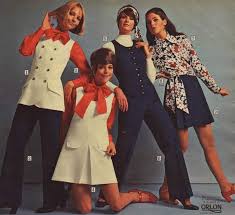The Timeless Charm of 70s Fashion for Women
Step back in time to the groovy era of the 1970s, where fashion was bold, expressive, and truly iconic. The 70s fashion for women was a unique blend of bohemian chic, disco glamour, and vintage vibes that continue to inspire designers and fashionistas today.
One of the key elements of 70s fashion for women was the bohemian trend. Flowy maxi dresses, fringe details, peasant blouses, and floral prints dominated the boho-chic style of the decade. Women embraced their free-spirited nature with earthy tones, natural fabrics like cotton and suede, and statement accessories such as floppy hats and oversized sunglasses.
On the other end of the spectrum was disco fashion, which brought sequins, metallic fabrics, and bold colours to the forefront. Women channelled their inner diva with shimmering disco dresses, high-waisted flared trousers, platform shoes, and glittering accessories that sparkled under the dance floor lights.
The influence of 70s fashion can still be seen on today’s runways and streets. Designers often incorporate elements like bell sleeves, wide-leg trousers, denim jumpsuits, and retro prints into their collections as a nod to this vibrant era.
Whether you’re looking to add a touch of 70s flair to your wardrobe or fully embrace the retro aesthetic, there are endless ways to incorporate elements of 70s fashion into your personal style. From flowing bohemian dresses for a music festival vibe to sleek jumpsuits for a night out on the town, the options are as diverse as they are stylish.
Embrace the timeless charm of 70s fashion for women and let your inner flower child or disco queen shine through in every outfit you wear!
Embracing the Vibrance: Five Reasons to Celebrate 1970s Women’s Fashion
- 1. Iconic Style
- 2. Versatile Trends
- 3. Retro Revival
- 4. Comfortable Fabrics
- 5. Statement Accessories
Exploring the Downsides of 1970s Women’s Fashion: Body Diversity Shortcomings, High Maintenance, and Outmoded Styles
1. Iconic Style
The 70s fashion for women boasts an iconic style that has left a lasting impact on the world of fashion. From the bohemian chic to disco glamour, the distinct aesthetic of the era remains a source of inspiration for contemporary designers and fashion enthusiasts alike. The memorable silhouettes, bold patterns, and unique textures of 70s fashion continue to shape and influence modern trends, proving that true style is timeless and always in vogue.
2. Versatile Trends
The 70s fashion for women was characterised by its versatility, offering a diverse range of trends to suit various styles and personalities. From the laid-back bohemian chic with its flowy maxi dresses and earthy tones to the glitzy disco glamour featuring sequins and metallic fabrics, the fashion landscape of the 70s had something for everyone. Women could express their individuality through a multitude of trends, making it a decade where personal style truly flourished.
3. Retro Revival
Embracing 70s fashion enables you to tap into a retro revival trend that adds a unique and nostalgic touch to your wardrobe. By incorporating elements of 70s style such as bold prints, flared trousers, and statement accessories, you can effortlessly infuse your look with a sense of vintage charm that sets you apart from the crowd. The resurgence of 70s fashion in contemporary trends offers a refreshing opportunity to pay homage to the past while putting your own modern spin on iconic retro pieces.
4. Comfortable Fabrics
In 70s fashion for women, the emphasis on comfortable fabrics such as cotton, denim, and suede not only adds a touch of authenticity to the era’s style but also prioritizes both comfort and style. These natural materials not only feel soft against the skin but also allow for ease of movement, making them ideal choices for everyday wear. Whether it’s a flowing bohemian dress in breathable cotton or a pair of high-waisted flared jeans in durable denim, the use of these fabrics in 70s fashion embodies a perfect blend of comfort and fashion-forward design.
5. Statement Accessories
In the vibrant world of 70s fashion for women, one standout pro was the emphasis on statement accessories. The era celebrated boldness with oversized sunglasses, floppy hats, and chunky jewellery that had the power to transform any outfit into a true fashion statement. These eye-catching accessories added a touch of glamour and individuality to women’s ensembles, allowing them to express their unique style and personality with confidence and flair.
1. Limited Body Diversity
In examining the drawbacks of 70s fashion for women, one notable con was its tendency to promote a limited body diversity ideal. The fashion trends of the era often favoured a slim and tall silhouette, which could inadvertently exclude women with diverse body types from feeling represented or included in the prevailing style norms. This emphasis on a specific body shape may have perpetuated unrealistic beauty standards and hindered the celebration of all body sizes and shapes within the fashion industry during that time.
2. Maintenance Intensive
In the realm of 70s fashion for women, a notable downside was its maintenance-intensive nature. Certain fabrics and styles from this era demanded meticulous care, with delicate materials that easily wrinkled or proved challenging to clean. This aspect added an extra layer of effort and time-consuming tasks to the upkeep of one’s wardrobe, making it a con for those seeking practicality and convenience in their clothing choices.
3. Outdated Trends
In the realm of 70s fashion for women, one notable con lies in the presence of outdated trends. Although certain elements of 70s style have experienced a resurgence in popularity, there are aspects of that era’s fashion that may now seem outmoded or less pertinent in today’s contemporary fashion scene. Styles that were once celebrated during the 70s may not always translate seamlessly into current trends, highlighting the ever-evolving nature of fashion and the selective revival of nostalgic elements from past decades.

